Timeline: The Odyssey
An interactive website for The Odyssey , written by Homer .
- After the Trojan war, Odysseus and his men set sail from Troy.
- They plunder the Cicones but are routed by reinforcements.
- On the island of the lotus eaters , some men eat the food of the enchanting inhabitants and loose all hope of home.
- On the Island of the Cyclops, Odysseus's curiosity causes him trouble: he and twelve others are imprisoned by the cannibal Polyphemus . They blind him in order to escape.
- At Aeolia, the wind king Aeolus offers to help Odysseus. He bags up all the winds and places them on Odysseus's ship. But Odysseus's foolish crew open the bag, thinking it is treasure. The winds become a storm and blow the ships back to the island. Aeolus is angry at their irresponsibility and sends them away.
- They arrive at an island inhabited by cannibals who destroy all of the ships except for Odysseus's.
- Next they land on Aeaea, where the enchantress Circe lives. She turns some of the men into pigs. Later, she restores them and sends Odysseus on a lone quest to the Land of the Dead.
- In the Land of the Dead, Odysseus sees his mother who died while waiting for him to return home. Next, A blind prophet named Teiresias gives Odysseus a warning and a promise: Odysseus will arrive home, but all the other men will die.
- Odysseus and his men return to Aeaea. Circe warns him of three perils that await him: the Sirens, Scylla , and Charybdis . They set sail and manage to avoid the danger.
- After their adventures, they arrive at the island of Helios . Eventually, the crew get discouraged and kill the holy cattle for food. Zeus kills all the crew except for Odysseus.
- Odysseus arrives at Calypso's island where he is held captive for seven years.
- At Athena's urging, the gods on Mount Olympus decide it is time for Calypso to free Odysseus.
- Telemachus sets sail to find information about his father. Nestor tells Telemachus that he should ask King Menelaus about his father. King Menelaus tells Telemachus that Odysseus is being held by Calypso .
- Calypso releases Odysseus, and he builds a raft and sets sail.
- Poseidon , who holds a grudge against Odysseus, destroys the raft in a storm. Odysseus washes up on an island.
- A young girl named Nausicaä finds Odysseus and leads him to the city. Athena appears to Odysseus and leads him to the palace of Alcinous.
- The king invites Odysseus to the feast if he will entertain them for a while. The next day, the king holds a party for Odysseus. They play games and a minstrel sings for Odysseus. Odysseus tells his tale in the courts. Afterward, King Alcinous gives him passage to Ithaca . Athena disguises him as an old beggar.
- Odysseus travels to the hut of his old swineherd, Eumaeus. Eumaeus doesn't recognize Odysseus because of the disguise, but he politely entertains Odysseus.
- Athena appears to Telemachus and advises him to return to his home.
- Telemachus meets his father.
- Telemachus, followed by Odysseus, travels to the palace. There, Odysseus is first recognized by his faithful hunting dog, Argos.
- Another beggar from the local town arrives and tries to drive Odysseus out.
- Still disguised as a beggar, Odysseus tells Penelope that he met Odysseus in his travels. The nurse recognizes Odysseus by his scar, but Odysseus quickly tells her not to tell Penelope.
- Odysseus is nervous about his upcoming task. Athena reassures him that the suitors will die.
- Penelope creates a test to prevent the suitors from marrying her: they must string Odysseus's huge bow—a task that only he can do. All the others fail, but Odysseus is successful. The suitors still ignore the beggar.
- Odysseus defeats the suitors.
- Penelope finally recognizes Odysseus as her husband.
- Odysseus visits his father, king Laertes , but the relatives of the suitors have gathered to revenge. Laertes kills the leader, but Athena interrupts them before anything else can happen. She commands them to end the violence.
Bibliography


Access and Info for Institutional Subscribers
Odyssey's timeline.
Created by Lucía García on Thu, 06/30/2022 - 04:37
Part of Group:
In this post you'll be able to see clearly the steps of Ulysses' journey and how long he spent in every spot of the Aegean Sea.
Bear in mind that it tells of events that supposedly occurred in the Mycenaean period (XVII century BC - XII century BC) while Homer is said to have written them down in the Archaic period, around the 8th century BC.
For this reason, it is impossible to find the dates on which each of the events narrated took place. However, we can know how much time Ulysses spent in the different stages of his journey because of the numerous time references he makes when telling his story. Moreover, this platform doesn't allow us to write numbers with less than four digits. Therefore, in this timeline the dates are arranged in this way, being the year 1001, the year in which the Trojan War begins, as it is the beginning of Ulysses' journey, even though it isn't even set in the right millenium
Chronological table

- +353 (0) 876087916
- [email protected]
- Go to Ancient Origins
Search form

The Itinerary of Odysseus, an Ancient Treasure Map
- Roberto Volterri's blog

- By Roberto Volterri
- Mythology & Mystery
Did Homer’s Odyssey contain a secret code, that would guide the Greeks to gain complete control over the Black Sea and the North Atlantic and access to the riches of precious metals and other treasures? Was the Odyssey not only a heroic poem, but actually intended as a coded secret ancient treasure map? Dr Roberto Volterri takes on the challenge of the odyssey of discovery as suggested by the author Gilbert Pillot in his (1972) The Secret Code Of The Odyssey; Did The Greeks Sail The Atlantic? Only those who had committed to their memory the detailed descriptions of the routes followed by the Greek hero Odysseus and, at the same time, had possessed the 'secret code of deciphering' would be able to retrace the same routes, to find the same places visited by Odysseus and to take possession of the wealth (metals or other natural resources) of which those places abounded.
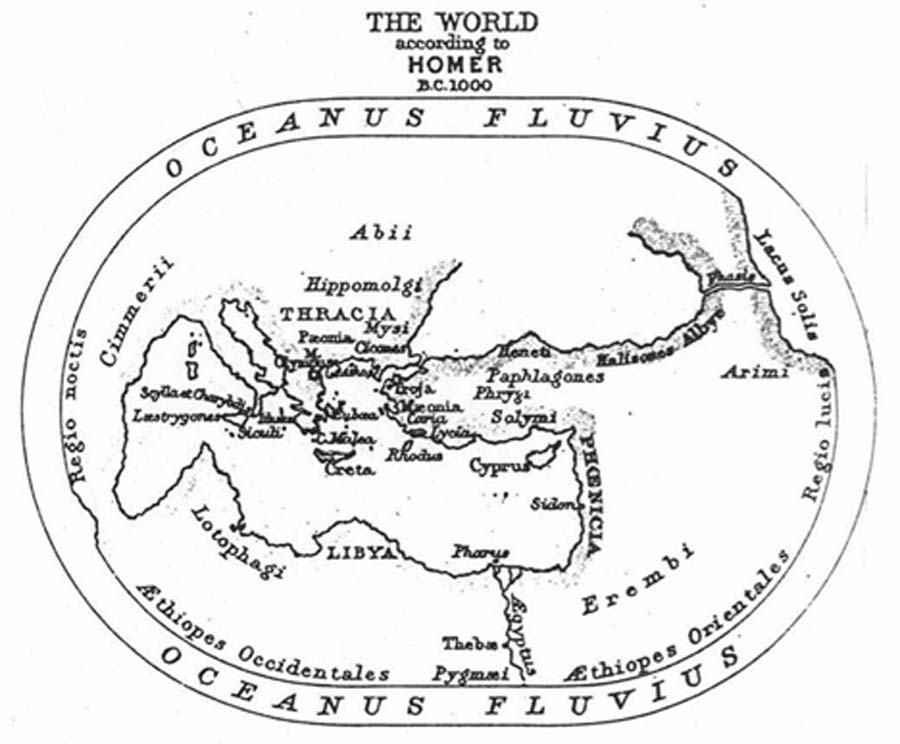
Homer's conception of the world during the Heroic era. From The Challenger Reports (1895) ( Public Domain)
The theory proposes that Homer , through the mouth of Odysseus, wanted to indicate - stage by stage of the long and perilous journey - a whole series of complementary facts, which could act as a guide to the initiated successors of the Achaeans (Greeks who fought in the Trojan War) to reveal to them the secret to deciphering the code, which could have lead them to the locations of treasures. Could these treasures not only be tangible, but also perhaps explain the ‘Greek miracle’ of the sudden development of the arts, sciences and general knowledge explosion of the Greeks by the fifth century? To decipher with some accuracy the real routes followed by Odysseus, perhaps one of the 'keys’ is to consider the direction of the winds that propelled Odysseus’ ship during its long voyage.
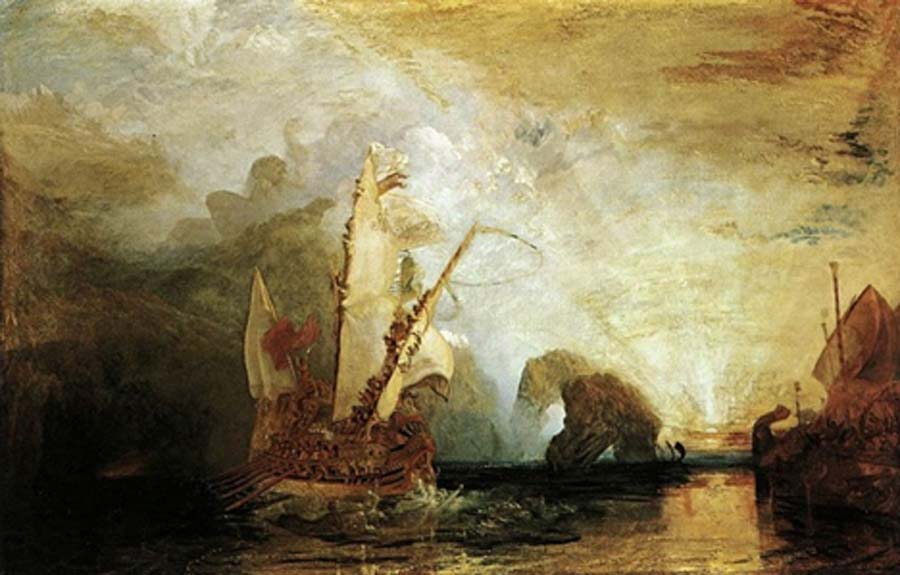
Odysseus Deriding Polyphemus by Joseph Mallord William Turner (1829) Web Gallery of Art ( Public Domain )
In summary the events described in Homer’s Odyssey refer chronologically to the years immediately following the conquering of the city of Troy by the Achaeans (Greeks), around the end of the 13th and the beginning of the 12th century BC. At that time sailing could only make use of the classic stern wind, since the so-called 'Latin sail', which allowed sailing even against the wind, was introduced much later. So, when Homer narrates that Odysseus' ship - equipped with a square sail useful only with the wind coming from the stern of the boat - was propelled by the wind of Boreas, the name by which the Greeks called the wind coming from the north, one has to conclude that the ship was definitely heading south.
To follow Odysseus’ classical itinerary, he leaves the country of the Cicones - north of the Aegean (modern-day Turkey) - to head towards Cape Malea, on the south coast of Greece. Similarly, when Homer describes Odysseus’ ship propelled by the wind, Zephyr, one concludes that the route is eastwards, while when it is propelled by the Euro, it is westwards, and so on.
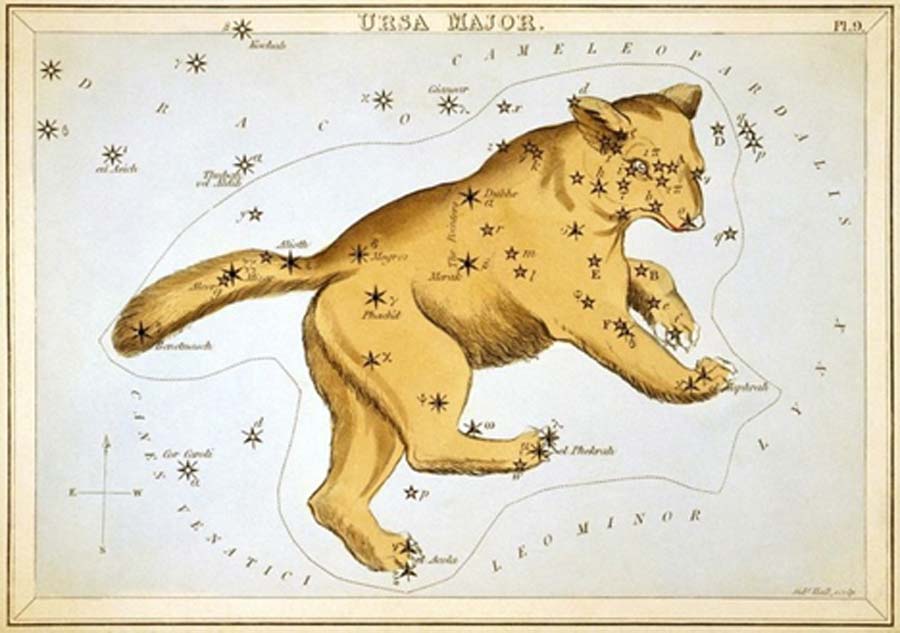
Ursa Major, plate 9 in Urania's Mirror, a set of celestial cards accompanied by ‘A familiar treatise on astronomy’ by Jehoshaphat Aspin (1825) ( Public Domain )
Become a member to read more OR login here


Oxford University Press's Academic Insights for the Thinking World

A map of Odysseus’s journey

The Odyssey
Odysseus--soldier, sailor, trickster, and everyman--is one of the most recognizable characters in world literature. His arduous, ten-year journey home after the Trojan War, the subject of Homer's Odyssey , is the most accessible tale to survive from ancient Greece, and its impact is still felt today across many different cultures.
- June 26 th 2014
Homer’s epic poem The Odyssey is a classic adventure filled with shipwrecks, feuds, obstacles, mythical creatures, and divine interventions. But how to visualize the thrilling voyage?
The map below traces Odysseus’s travel as recounted to the Phaeacians near the end of his wandering across the Mediterranean. Odysseus’s ten-year trek began in Asia Minor at the fallen city of Troy (the green marker) following the end of the Trojan War. His ultimate destination: his home in Ithaca (the red marker). Click the markers for information on each step of his journey. It is important to note that the 14 locations plotted on this map have been widely debated by both ancient and modern scholars.
Barry Powell, translator of a new edition of The Odyssey , asserts that the currently agreed upon location of the Island of the Sun (#11) is in fact modern-day Sicily. However, the characters in The Odyssey are in “never-never land,” and consequently, the locations plotted cannot be deemed entirely accurate.
Headline image credit: Ulysses and the Sirens by John William Waterhouse, 1891. Public domain via Wikimedia Commons .
Barry B. Powell is Halls-Bascom Professor of Classics Emeritus at the University of Wisconsin, Madison. His new free verse translation of The Odyssey was published by Oxford University Press in 2014. His translation of The Iliad was published by Oxford University Press in 2013.
- Arts & Humanities
- Classics & Archaeology
- Images & Slideshows
Our Privacy Policy sets out how Oxford University Press handles your personal information, and your rights to object to your personal information being used for marketing to you or being processed as part of our business activities.
We will only use your personal information to register you for OUPblog articles.
Or subscribe to articles in the subject area by email or RSS
Related posts:

Recent Comments
There is NO ‘republic of Macedonia! There’s only a so-called Former Yugoslav Republic of Macedonia (FYROM). Please amend your map. You of all to make such mistake?! It’s disgraceful.
Well, your work is an excellent one and enjoyed it. However, I would like to point out that your map has a huge mistake.Does not exist a state named “Republic of Macedonia”, it is FYROM. So if you want to be accepted by Greeks “Hellines”, you have to correct that name at once. FYROM did not exist at the times of Odysseus, they appeared in that territory many-many centuries later from the NE Slaves.
EDITOR’S NOTE:
The map above was created using Mapbox, which sources its geography from Open Street Map. All countries and locations named on the underlying map are modern. The former Yugoslav Republic of Macedonia is commonly referred to as ‘Republic of Macedonia’ in English for brevity (as ‘Italy’ instead of ‘Italian Republic’). This is reflected in the Open Street Map data and is not the direct work of the authors or editors.
Alice Northover OUPblog Editor
Thank you of your reply. In any case any official organization must not accept to participate to the propaganda game of Scopia.Their real old name was and is “Vardaska”. So we, Hellines, will never accept to play their game.In any case, if they want to belong to the Hellenic recent history, they have to ask their union with Hellenic state. Regarding “brevity” this is another of their games…..
Since you are interested of Greek/Hellenic history, please see/read new articles regarding recent discovery at ancient Amphipolis of Macedonia.This is the real history and not the constructed one.
Please do not seek in the Mediterranean!
Homeros was not a fanciful poet.
I say: explorations for Homeros should also be in the Netherlands, where in the ever sinking delta formerly was situated the land Phtia, twice a day inundated by the sea. Clay soils it had, with coarse clods, and the king was married to a sea goddess. Maps have recently been reconstructed.
Who wrote this
Comments are closed.
Travels of Odysseus
Use this geotour to follow Odysseus and his crew as they encounter nymphs and narcotics, cyclopes and sirens.
English Language Arts, Geography, Human Geography
Loading ...
The Odyssey is an epic , an adventure story attributed to the Greek poet Homer . Most historians think The Odyssey was composed in the 7th or 8th century B.C.E. The Odyssey tells the adventures of the Greek hero Odysseus, a veteran of the Trojan War . ( The Odyssey is a sequel to Homer's other epic, The Iliad , which tells the story of that war.) Cursed by Poseidon, god of the sea, but favored by Athena, goddess of wisdom, Odysseus sails the eastern Mediterranean for 10 years before reaching his home and family on the island of Ithaca. Use this geotour to follow Odysseus and his crew as they encounter nymphs and narcotics , cyclopes and sirens .
Geography of The Odyssey
No map of The Odyssey is definitive. “You will find the scene of Odysseus’ wanderings when you find the cobbler who sewed up [his] bag of winds.” So wrote the ancient Greek geographer Eratosthenes in the 2nd century B.C.E. Nevertheless, countless geographers, classicists, historians, and literary critics have speculated on the landmarks of Homer’s epic. Some speculations are more exotic than others—from the Azores to the Amazon, the Caribbean to Great Britain.
Inspired by The Odyssey
The travels of Odysseus have inspired writers for more than 2,000 years.
- The Roman poet Virgil wrote The Aeneid in the late 1st century B.C.E. The Aeneid is the story of Aeneas, as The Odyssey is the story of Odysseus. Both books tell the legend of the Trojan Horse, and both the Trojan Prince Aeneas and the Greek King Odysseus have adventures throughout the eastern Mediterranean. (Aeneas and his company of Trojans go on to settle in the western Italian region of Latium—where they became the founders of Rome.)
- Ulysses, by James Joyce, was published in 1922. Widely regarded as one of the most important English-language novels of the 20th century, Ulysses is a day in the life of two friends, Stephen Dedalus and Leopold Bloom. As Odysseus met unanticipated adventures as he roamed the Mediterranean for 10 years, so Dedalus and Bloom meet everyday adventures on their errands and strolls through Dublin, Ireland, on June 16, 1904.
- The Penelopiad , published in 2005, is Margaret Atwood’s “parallel novel” to The Odyssey . The Penelopiad tells the story of Odysseus’ wife, Penelope, from her own point of view. She recounts her childhood, her marriage, and how she governed the kingdom alone for 20 years. Penelope, narrating from the underworld of the 21st century, wonders why Odysseus’ stories have survived for so long, when Odysseus himself admits to being an accomplished liar.
The Odyssey
The travels of Odysseus form just one part of The Odyssey . Another part, called the Telemachy, focuses on Odysseus’ son, Telemachus, who left home in search of his long-lost father. The final section of The Odyssey is called the Nostos (“homecoming” in Greek). The Nostos addresses Odysseus’ adventures once he returns to Ithaca: meeting Telemachus, who was an infant when Odysseus left two decades earlier; slaughtering his wife’s suitors—the men who would take Odysseus’ place as king; and, finally, reuniting with Queen Penelope, who had remained a faithful wife for 20 years.
Media Credits
The audio, illustrations, photos, and videos are credited beneath the media asset, except for promotional images, which generally link to another page that contains the media credit. The Rights Holder for media is the person or group credited.
Last Updated
April 22, 2024
User Permissions
For information on user permissions, please read our Terms of Service. If you have questions about how to cite anything on our website in your project or classroom presentation, please contact your teacher. They will best know the preferred format. When you reach out to them, you will need the page title, URL, and the date you accessed the resource.
If a media asset is downloadable, a download button appears in the corner of the media viewer. If no button appears, you cannot download or save the media.
Text on this page is printable and can be used according to our Terms of Service .
Interactives
Any interactives on this page can only be played while you are visiting our website. You cannot download interactives.
Related Resources
To print the story please do so via the link in the story toolbar.

A Timeline of the Odyssey
A long time ago, in the land of Greece, there lived a man named Odysseus. When the Trojan War broke out, Odysseus left his home in Ithaca to go fight in Troy. His journey back from the war took a little bit longer than expected, more or less 10 years longer than expected. The following timeline will chronicle Odysseus's journey from the time he left Ithaca, to when he was first shown in Homer's "The Odyssey", as a captive for the nymph Calypso.
The Trojan War
The Trojan War lasted from approximately 1190 BCE to 1180 BCE, and was a battle between the Greeks and the Trojans. Our protagonist, Odysseus, left from his home in Ithaca and went to Troy to fight the Trojans.

Greek fighters attacking with the Trojan horse.
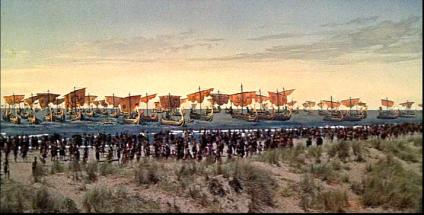
Greek ships landing on the shores of Troy.
In "The Odyssey", the story beings in medias res (in the midst of things), and the Trojan War has already concluded. The focus of this Timeline is Odysseus's journey after the war in trying to get home to Ithaca.
Did you know?
Odysseus is also known as Ulysses, mainly by the Romans.
From the War to the Giant
After leaving Troy, the first stop that Odysseus and his men made was in Ismarus, in the land of the Cicones. Odysseus and his crew killed the men and briefly took over, and managed to leave right as the reinforcements showed up.
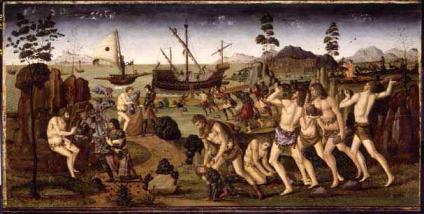
Odysseus and his men in the land of the Cicones.

Odysseus's men relaxing with the Lotus Flowers.
When one eats the flower, they are described to react as stated: "any crewmen who ate the lotus...lost all desire to send a message back, much less return, their only wish to linger there with the Lotus-eaters, grazing on Lotus, all memory of the journey home dissolved forever."

The Lotus Flower.
10 days after leaving Ismarus, the ship stopped at the land of the "Lotus Eaters". During their brief visit, in which the purpose was to eat and rest, a few of Odysseus's crewmen ate some of the Lotus Flowers. This forced Odysseus to hurry his men back onto the ship to continue the journey.
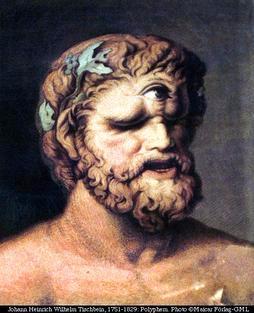
Polyphemus.
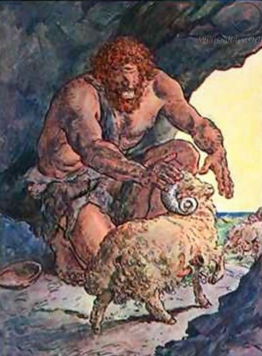
Polyphemus in his cave, with one of his rams.
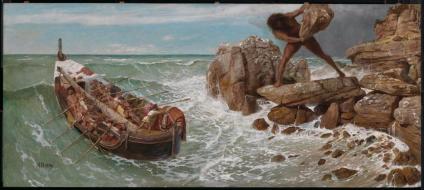
Polyphemus tossing a boulder at Odysseus's retreating ship.
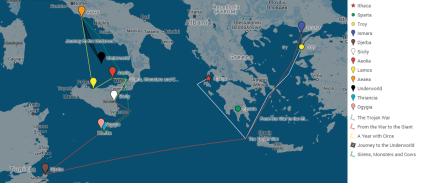
When travelling back home, Odysseus and his crew were pushed off far off course, landing them in Ismarus, which in the present-day, is an island off the coast of Tunisia. They then went to Sicily, which is where Polyphemus and the other Cyclopes lived, and travelled around Italy for the next 2 years before Odysseus was captured by Calypso.
Odysseus and his men had quite an encounter in the land of the Cyclopes.
- Following their arrival, the crew ended up at the cave of a certain Cyclops.
- The men tried to be friendly towards the Cyclops, and they assumed the Cyclops would be hospitable and welcoming like anyone else.
- Unfortunately this was not the case, and two of Odysseus's men were eaten.
- The next day, after the Cyclops ate two more men, Odysseus managed to get the Cyclops drunk, and then stabbed the Cyclops in the eye, consequently blinding the Cyclops, who's name, Polyphemus, is now revealed.
- Odysseus and his men manage to escape from Polyphemus's cave, which is when things go south.
- Odysseus decides to showboat and taunts Polyphemus. Furthermore, he reveals his own name and where he is from, which is a horrible idea.
- Polyphemus decides to run to his dad, Poseidon, who in turn curses Odysseus and his crew as they depart from the land.
Want to Create a Timeline Like This One? 😎

Sutori is a free creation tool that allows you to build beautiful timelines with an easy to use interface.
➡️ see some great timelines here ., a year with circe.
Following the escape from Polyphemus, things began looking good for Odysseus and his crew to return to Ithaca. They went to Aeolia, and met with Aeolus, the God of the Winds. He gave them a bag of storm winds to help push them back to Ithaca, and they were on their way.

Aeolus handing Odysseus the bag of winds.
When he and his crew could finally see Ithaca on the horizon, Odysseus decided to finally take a nap. His crew had the great idea to open up the bag of winds, and when they opened it, it blew them back to where they came from.
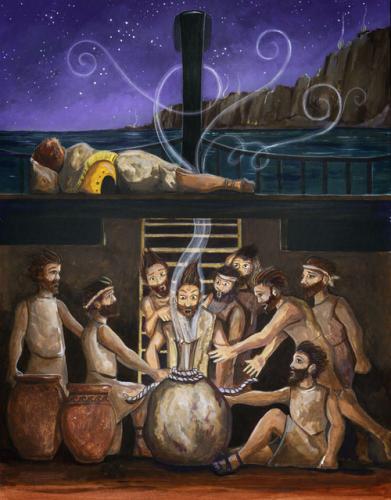
Odysseus's crew opening the bag of winds while their leader is asleep.
When they went back to Aeolus to ask for his help again, the God realized the men were cursed, and refused to help. The crew left, and landed in Lamos, the land of the Laestrygonians. Their stay was quite quick, after the King tried to drink the crewmen's blood.

The Laestrygonians.
The next stop on the journey home is the land of Aeaea, home of the goddess, Circe. After sending a group of his men to search the land, and finding out they have all been turned to pigs, Odysseus pays a visit to Circe.
Odysseus is given "moly" by Hermes to prevent him from turning into a pig. One thing led to another, and Odysseus and Circe end up having sex. They continue their relationship for a whole year, as Odysseus and his crew forget about home while in Aeaea.
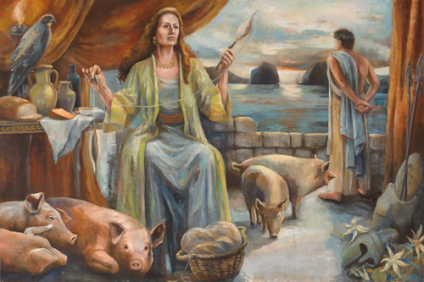
Circe, with the pigs, and Odysseus standing in the back.
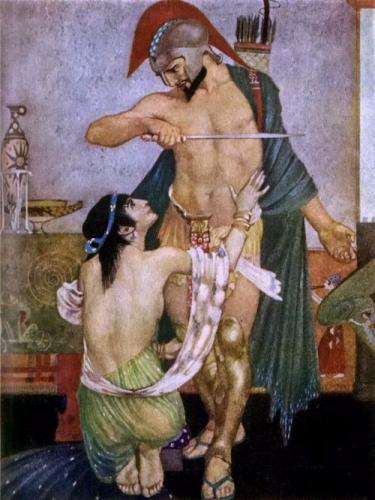
Odysseus and Circe.
Journey to the Underworld
When it was time to leave Aeaea, Circe told the men they needed to go to the Underworld before going back to Ithaca. As they left, they left behind one of their crew members, Elpenor, who had fallen off the roof the night before and died.

An illustration of Odysseus approaching the Underworld.
When they reached the Underworld, Odysseus encountered various ghosts. The first was the one person they left behind, Elpenor. Elpenor asked that they go back and properly bury him.
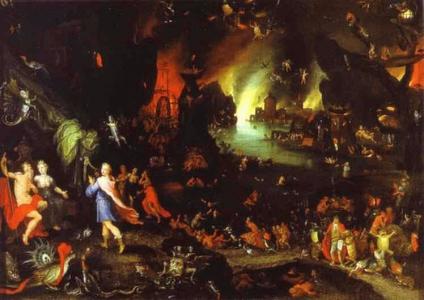
The Underworld.
Odysseus talked to many ghosts, including:
- The ghost of his mother, who tells him she died of loneliness
- The ghost of Teiresias, who gave warnings of the future of Odysseus and his crew
- The ghosts of Princesses
- The ghost of Agamemnon, who told him what had happened to him that led to his death
- The ghosts of companions from the Trojan War (i.e. - Achilles)
- The ghosts of other Greek figures

Odysseus being told about his future by Teiresias.
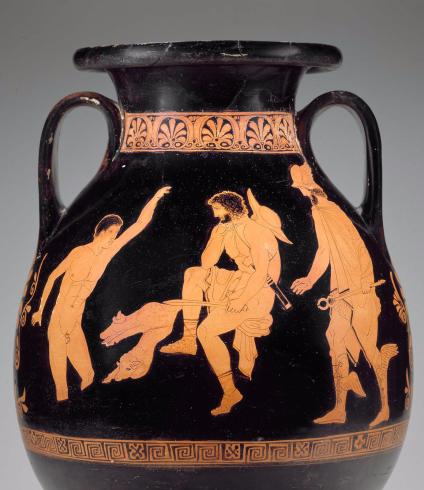
Jar that depicts Elpenor talking to Odysseus in the Underworld.
Sirens, Monsters and the Cows
Odysseus and his crew returned to Aeaea to give Elpenor a proper burial. Circe greets them, and after her and Odysseus catch up for a bit, she gives the men directions on getting home.
First up for the crew: The Sirens. Getting by the Sirens was an impossible task, as their beautiful song drew anyone who heard it in. In order to get through the Sirens, Odysseus had his men tie him to a pole, and put wax in their ears so they would not hear the Sirens.

Odysseus tied up as the Sirens surrounded the ship.
After getting through the Sirens, the crew had to get by the monsters, called Scylla and Charybdis. Odysseus had to sacrifice 6 of his men by going past Scylla as opposed to losing the whole ship if they were to go by Charybdis.

Odysseus and his crew trying to get by Scylla.
Despite losing 6 men, Odysseus and his men stopped to rest on Thriancia, home of Helios's cows. When the men woke up the next morning, there was a storm, so they has to stay. This storm lasted for the next 30 days, and eventually the men ran out of food.
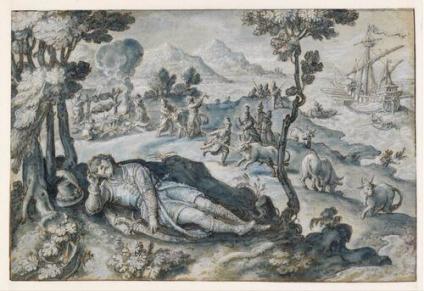
Odysseus sleeps as his men chase down one of Helios's cows
After receiving clear instructions not to eat the cows, while Odysseus was asleep, the crew did just that. Helios, enraged, asked his friend Zeus to punish the men for what they had done.
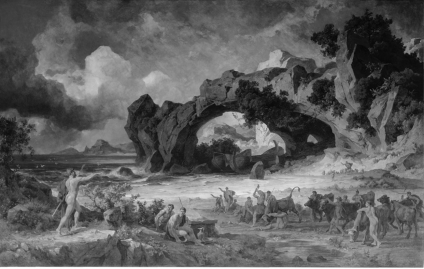
Another depiction of Odysseus and his men at Thriancia.
Zeus sent down a large lightning storm, killing everyone but Odysseus, who floats on, and somehow survives Charybdis by clinging to a tree.
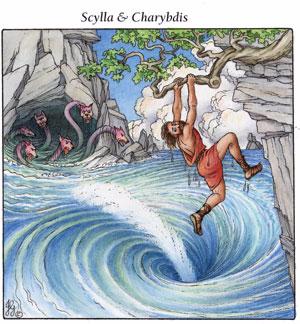
Odysseus hanging on to a tree to avoid being swallowed by Charybdis.
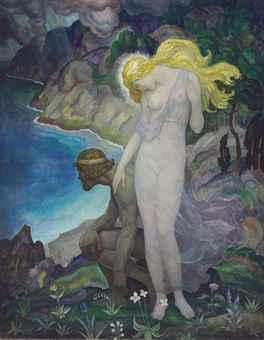
Captured by Calypso
Odysseus, after surviving everything that happened, floated to the shore of Ogygia, and was rescued by Calypso. Calypso held him captive for 7 years, after which Odysseus manages to get himself to Nausicaa, and eventually makes his return to Ithaca.
The best free cultural &
educational media on the web
- Online Courses
- Certificates
- Degrees & Mini-Degrees
- Audio Books
Odyssey ">An Interactive Map of Odysseus’ 10-Year Journey in Homer’s Odyssey
in Literature , Maps | June 13th, 2019 13 Comments
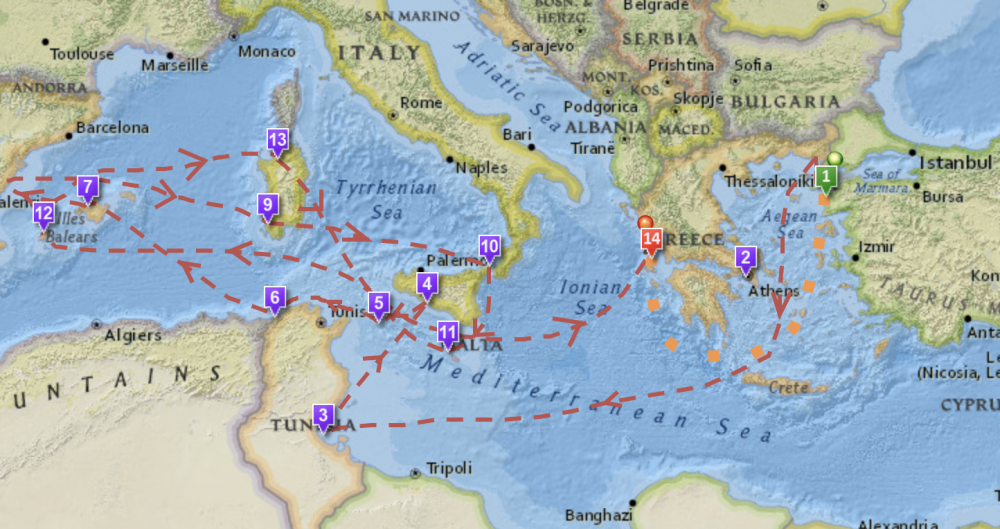
The Odyssey , one of Homer’s two great epics, narrates Odysseus’ long, strange trip home after the Trojan war . During their ten-year journey, Odysseus and his men had to overcome divine and natural forces, from battering storms and winds to difficult encounters with the Cyclops Polyphemus, the cannibalistic Laestrygones, the witch-goddess Circe and the rest. And they took a most circuitous route, bouncing all over the Mediterranean, moving first down to Crete and Tunisia. Next over to Sicily, then off toward Spain, and back to Greece again.
If you’re looking for an easy way to visualize all of the twists and turns in The Odyssey , then we’d recommend spending some time with the interactive map created by Gisèle Mounzer . “Odysseus’ Journey” breaks down Odysseus’ voyage into 14 key scenes and locates them on a modern map designed by Esri, a company that creates GIS mapping software.
Meanwhile, if you’re interested in the whole concept of ancient travel, we’d suggest revisiting one of our previous posts: Play Caesar: Travel Ancient Rome with Stanford’s Interactive Map . It tells you all about ORBIS , a geospatial network model, that lets you simulate journeys in Ancient Roman. You pick the points of origin and destination for a trip, and ORBIS will reconstruct the duration and financial cost of making the ancient journey.
If you would like to sign up for Open Culture’s free email newsletter, please find it here . Or follow our posts on Threads , Facebook , BlueSky or Mastodon .
If you would like to support the mission of Open Culture, consider making a donation to our site . It’s hard to rely 100% on ads, and your contributions will help us continue providing the best free cultural and educational materials to learners everywhere. You can contribute through PayPal , Patreon , and Venmo (@openculture). Thanks!
Note: An earlier version of this post appeared on our site in December, 2013.
Related Content:
Hear Homer’s Iliad Read in the Original Ancient Greek
What Ancient Greek Music Sounded Like: Hear a Reconstruction That is ‘100% Accurate’
Discover the “Brazen Bull,” the Ancient Greek Torture Machine That Doubled as a Musical Instrument
Learning Ancient History for Free
by OC | Permalink | Comments (13) |
Related posts:
Comments (13), 13 comments so far.
The name of the country north of Macedonia (i.e. the region of Greece) is North Macedonia (Severna Makedonija). Please, change your map according to the international agreements.
Not to worry…Macedonia is north of Greece..so is west,east,north and south Macedonia.
No need to change any maps at this time as this fictitious country will self-destruct and cease toexist in a very short time except as absorbed by its surrounding counties.
Circe’s location is usually thought to be Mount Circeo, south of Rome…never heard of it been identified with the Baleares
I couldn’t get the map to load. It said it had a fatal error. :-(
Same problem for me
The link appears broken, map fails with “Fatal error”, bit like in a Greek tragedy ..
I also got a fatal error. Is the map possibly restricted in which countries it can be viewed?
erm what the sigma
umm what the sigma
Urm what the sigma
nice guys always finished last shouldve known that gave you my hear and you f around and broke that. so sad. girl yu played me did me so shady come on now let me be ruthless
Erm what the sigma ohio. I like gooning and munting. I am the rizzler, I would love to meet the ultimate skibbidi. He is my idol. I hope baby gronk breaks up with livy dunne so i can mog all of them. I love kai cenats big toe.
Add a comment
Leave a reply.
Name (required)
Email (required)
XHTML: You can use these tags: <a href="" title=""> <abbr title=""> <acronym title=""> <b> <blockquote cite=""> <cite> <code> <del datetime=""> <em> <i> <q cite=""> <s> <strike> <strong>
Click here to cancel reply.
- 1,700 Free Online Courses
- 200 Online Certificate Programs
- 100+ Online Degree & Mini-Degree Programs
- 1,150 Free Movies
- 1,000 Free Audio Books
- 150+ Best Podcasts
- 800 Free eBooks
- 200 Free Textbooks
- 300 Free Language Lessons
- 150 Free Business Courses
- Free K-12 Education
- Get Our Daily Email
Free Courses
- Art & Art History
- Classics/Ancient World
- Computer Science
- Data Science
- Engineering
- Environment
- Political Science
- Writing & Journalism
- All 1500 Free Courses
- 1000+ MOOCs & Certificate Courses
Receive our Daily Email
Free updates, get our daily email.
Get the best cultural and educational resources on the web curated for you in a daily email. We never spam. Unsubscribe at any time.
FOLLOW ON SOCIAL MEDIA
Free Movies
- 1150 Free Movies Online
- Free Film Noir
- Silent Films
- Documentaries
- Martial Arts/Kung Fu
- Free Hitchcock Films
- Free Charlie Chaplin
- Free John Wayne Movies
- Free Tarkovsky Films
- Free Dziga Vertov
- Free Oscar Winners
- Free Language Lessons
- All Languages
Free eBooks
- 700 Free eBooks
- Free Philosophy eBooks
- The Harvard Classics
- Philip K. Dick Stories
- Neil Gaiman Stories
- David Foster Wallace Stories & Essays
- Hemingway Stories
- Great Gatsby & Other Fitzgerald Novels
- HP Lovecraft
- Edgar Allan Poe
- Free Alice Munro Stories
- Jennifer Egan Stories
- George Saunders Stories
- Hunter S. Thompson Essays
- Joan Didion Essays
- Gabriel Garcia Marquez Stories
- David Sedaris Stories
- Stephen King
- Golden Age Comics
- Free Books by UC Press
- Life Changing Books
Free Audio Books
- 700 Free Audio Books
- Free Audio Books: Fiction
- Free Audio Books: Poetry
- Free Audio Books: Non-Fiction
Free Textbooks
- Free Physics Textbooks
- Free Computer Science Textbooks
- Free Math Textbooks
K-12 Resources
- Free Video Lessons
- Web Resources by Subject
- Quality YouTube Channels
- Teacher Resources
- All Free Kids Resources
Free Art & Images
- All Art Images & Books
- The Rijksmuseum
- Smithsonian
- The Guggenheim
- The National Gallery
- The Whitney
- LA County Museum
- Stanford University
- British Library
- Google Art Project
- French Revolution
- Getty Images
- Guggenheim Art Books
- Met Art Books
- Getty Art Books
- New York Public Library Maps
- Museum of New Zealand
- Smarthistory
- Coloring Books
- All Bach Organ Works
- All of Bach
- 80,000 Classical Music Scores
- Free Classical Music
- Live Classical Music
- 9,000 Grateful Dead Concerts
- Alan Lomax Blues & Folk Archive
Writing Tips
- William Zinsser
- Kurt Vonnegut
- Toni Morrison
- Margaret Atwood
- David Ogilvy
- Billy Wilder
- All posts by date
Personal Finance
- Open Personal Finance
- Amazon Kindle
- Architecture
- Artificial Intelligence
- Beat & Tweets
- Comics/Cartoons
- Current Affairs
- English Language
- Entrepreneurship
- Food & Drink
- Graduation Speech
- How to Learn for Free
- Internet Archive
- Language Lessons
- Most Popular
- Neuroscience
- Photography
- Pretty Much Pop
- Productivity
- UC Berkeley
- Uncategorized
- Video - Arts & Culture
- Video - Politics/Society
- Video - Science
- Video Games

Great Lectures
- Michel Foucault
- Sun Ra at UC Berkeley
- Richard Feynman
- Joseph Campbell
- Jorge Luis Borges
- Leonard Bernstein
- Richard Dawkins
- Buckminster Fuller
- Walter Kaufmann on Existentialism
- Jacques Lacan
- Roland Barthes
- Nobel Lectures by Writers
- Bertrand Russell
- Oxford Philosophy Lectures
Receive our newsletter!
Open Culture scours the web for the best educational media. We find the free courses and audio books you need, the language lessons & educational videos you want, and plenty of enlightenment in between.
Great Recordings
- T.S. Eliot Reads Waste Land
- Sylvia Plath - Ariel
- Joyce Reads Ulysses
- Joyce - Finnegans Wake
- Patti Smith Reads Virginia Woolf
- Albert Einstein
- Charles Bukowski
- Bill Murray
- Fitzgerald Reads Shakespeare
- William Faulkner
- Flannery O'Connor
- Tolkien - The Hobbit
- Allen Ginsberg - Howl
- Dylan Thomas
- Anne Sexton
- John Cheever
- David Foster Wallace
Book Lists By
- Neil deGrasse Tyson
- Ernest Hemingway
- F. Scott Fitzgerald
- Allen Ginsberg
- Patti Smith
- Henry Miller
- Christopher Hitchens
- Joseph Brodsky
- Donald Barthelme
- David Bowie
- Samuel Beckett
- Art Garfunkel
- Marilyn Monroe
- Picks by Female Creatives
- Zadie Smith & Gary Shteyngart
- Lynda Barry
Favorite Movies
- Kurosawa's 100
- David Lynch
- Werner Herzog
- Woody Allen
- Wes Anderson
- Luis Buñuel
- Roger Ebert
- Susan Sontag
- Scorsese Foreign Films
- Philosophy Films
- February 2024
- January 2024
- December 2023
- November 2023
- October 2023
- September 2023
- August 2023
- February 2023
- January 2023
- December 2022
- November 2022
- October 2022
- September 2022
- August 2022
- February 2022
- January 2022
- December 2021
- November 2021
- October 2021
- September 2021
- August 2021
- February 2021
- January 2021
- December 2020
- November 2020
- October 2020
- September 2020
- August 2020
- February 2020
- January 2020
- December 2019
- November 2019
- October 2019
- September 2019
- August 2019
- February 2019
- January 2019
- December 2018
- November 2018
- October 2018
- September 2018
- August 2018
- February 2018
- January 2018
- December 2017
- November 2017
- October 2017
- September 2017
- August 2017
- February 2017
- January 2017
- December 2016
- November 2016
- October 2016
- September 2016
- August 2016
- February 2016
- January 2016
- December 2015
- November 2015
- October 2015
- September 2015
- August 2015
- February 2015
- January 2015
- December 2014
- November 2014
- October 2014
- September 2014
- August 2014
- February 2014
- January 2014
- December 2013
- November 2013
- October 2013
- September 2013
- August 2013
- February 2013
- January 2013
- December 2012
- November 2012
- October 2012
- September 2012
- August 2012
- February 2012
- January 2012
- December 2011
- November 2011
- October 2011
- September 2011
- August 2011
- February 2011
- January 2011
- December 2010
- November 2010
- October 2010
- September 2010
- August 2010
- February 2010
- January 2010
- December 2009
- November 2009
- October 2009
- September 2009
- August 2009
- February 2009
- January 2009
- December 2008
- November 2008
- October 2008
- September 2008
- August 2008
- February 2008
- January 2008
- December 2007
- November 2007
- October 2007
- September 2007
- August 2007
- February 2007
- January 2007
- December 2006
- November 2006
- October 2006
- September 2006
©2006-2024 Open Culture, LLC. All rights reserved.
- Advertise with Us
- Copyright Policy
- Privacy Policy
- Terms of Use

- Repeated Customers
- Booking Request
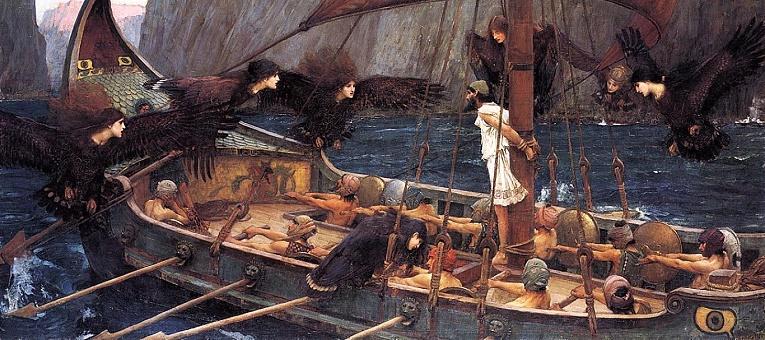
One hell of a sailor
Odysseus , a legendary hero and an ingenious man...
After his catalytic contribution to the Trojan War , with his inspiration of the Trojan Horse , a wooden structure which the Greeks used to infiltrate Troy, and a sample of our hero's strategic intelligence, the Trojan War comes to an end.
Odysseus begins his journey back to his homeland along with his comrades.
Tragically, after many adventures and losses, he is the only one who manages to return back to his homeland, Ithaca .
During his long voyage, Odysseus ' bravery and intelligence is proven many times over. But... was it bad luck that Odysseus ' unfortunate wandering lasted ten whole years, or was there a reason for this?
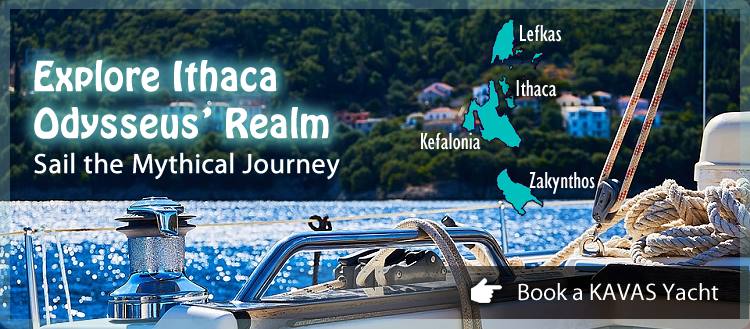
But... was Odysseus so unlucky after all, or there was a reason for this unfortunate wandering that lasted ten whole years?
THE ARDUOUS JOURNEY HOME
After the end of the Trojan war , Odysseus , like everyone else, began his long journey home, to the island of Ithaca. And yet, everyone managed to return to their loved ones except Odysseus who wandered for ten whole years through seas and countries far away from home, enduring many hardships until finally reaching Ithaca .
Starting from Troy , Odysseus had 12 ships at his disposal in which his comrades fought, and fell. This was of course no accident, seeing as the Gods of Olympus were very angry for the burning of their temples in Troy by the Greeks.
So, they sent their way strong and wild winds so as to punish them for their hubris by making their journey back home impossible.
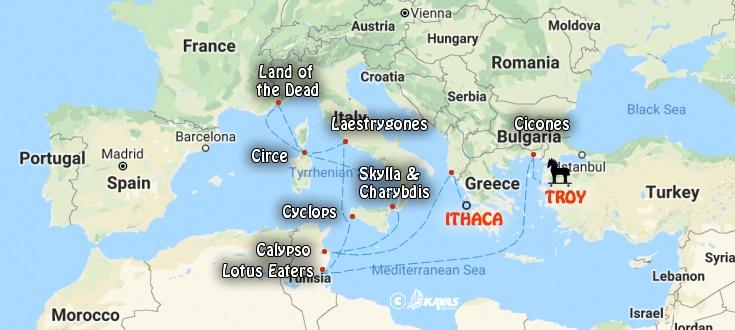
The Cicones
When Odysseus ’s ships were sailing in the Aegean, the gods sent wild winds to push them north into the land of the Cicones .
There, Odysseus and his men attack and fight some of the native Cicones , snatching animals and wine, and sitting by the beach to eat and drink. But when Odysseus tells his men that it is time to leave, they refuse, as the food is too good and the wine too sweet.
Shortly, all the Cicones gather and attack them together, killing many while the others quickly boarded the ships and left in a wild storm. Evidently, the lack of prudence and sobriety had cost many good men their very lives…
The lotus eaters
During their journey the strong winds blowing north pushed the ships away, in Africa . And so, Odysseus and his men arrived in the land of the Lotus Eaters .
Once ashore Odysseus sent three of his warriors to see what kind of people lived in this country. There, his men met the Lotus Eaters who offered them persimmons to eat, later revealed to be enchanted fruit!
Because of this enchantment, the men soon forgot their homeland and refused to leave the country of the Lotus Eaters.
Odysseus went to find them and took them back by force, immediately ordering the ships to sail.
According to Homer , it would seem to be quite a tragedy for someone to forget the place from which they came as well as their destination…
Polyphemus the Cyclops
Odysseus was known for being quick-witted even in the face of adversity.
After traveling for many days, the wind pushed their ships to the island of the Cyclops (Sicily).
After disembarking they went out and discovered a mighty cave close to the beach. Inside, they found milk, cheese, lambs and goats to eat.
But then Cyclops Polyphemus , son of Poseidon , who had only one eye, returned to his cave and discovered Odysseus and his men.
He shut the door of the cave with a huge rock and ate some of the men, saving the rest for later. The next day Odysseus offered Polyphemus sweet wine (the famous red wine, " Mavroudi " that is cultivated in several parts of Greece such as in Kea island ).
Nobody, is my name , he replied, and Polyphemus answered "You, Nobody, I will eat you last".
Then the Cyclop continued to drink until finally he fell asleep.
Odysseus then grabbed a branch and nailed it into the eye of Polyphemus. The Cyclop jumped up screaming and shouting for help.
The other Cyclops ran to his cave, "What happened, Polyphemus?", they asked. " Nobody blinded me !" answered Polyphemus .
"As nobody has blinded you, why are you shouting?" they wondered, and quickly left, making no sense of the Cyclop's words.
The next morning, blind Polyphemus opened the door of the cave and stood at the exit with his arms outstretched waiting to catch Odysseus and his men. But Odysseus, ingenious as he was, had tied his men under the bellies of the largest rams and he himself hung from the hair of the largest animal.
The Cyclop was stroking the rams' backs as they came out of the cave, and did not realize that there were people underneath.
When everyone was safely out of the cave, they ran to the ships and went away.
Island of Aeolus
Then they arrived to the island of Aeolus , the God of the winds . Aeolus welcomed them and hosted them for about a month.
When it was time for them to leave, the God Aeolus blessed Odysseus' journey with a favorable wind and handed him a sac where all the unfavorable ones were confined, so he could return immediately to Ithaca .
However, as they were approaching Ithaca , Odysseus' men opened the bag, causing a storm that destroyed 11 ships and swept away Odysseus to the island of Laestrygones .
Modern-day Greeks use the expression "opening the sac of Aeolus" to describe adverse situations with uncontrollable consequences (similar to the expression "opening a can of worms").
Fleeing the Laestrygonians
In the island of Laestrygonians Odysseus and his men were unwelcome.
As our hero and his comrades were approaching the harbor, the Laestrygonians , these wild and tall giants ran up against them, screaming and throwing boulders on the ships.
The rocks broke and sank the ships and the wild Laestrygonians ate all the men who were close. Only Odysseus' ship survived. He and his men quickly left the land of the wild Laestrygones.
The Sorceress Circe
The Greek hero and his men were driven to the island of Circe by the wind.
Odysseus then asked some of his men to go and ask where they were. The men soon found Circe ’s luxurious palace. Upon their arrival, the immortal sorceress offered them to feast and drink, unbeknownst to them that her goods would magically turn them into pigs , punishing them for their greedy appetite.
Only one of them managed to escape and went back to inform Odysseus. Without hesitation, he grabbed his sword and entered Circe 's palace, being immune to her magic with the help of god Hermes .
Amazed, Circe quickly became fond of Odysseus who eventually forced her to turn his comrades back to humans again.
They stayed in the island of Circe for a long time. When they decided to leave, Circe advised Odysseus to go to underworld and meet prophet Tiresias who would tell him how to get to Ithaca safely.
The Journey to the Underworld
Odysseus and his men arrived to underworld , a place no one ever dared trespass.
After a while the prophet Tiresias came to meet Odysseus and he asked the prophet what he has to do in order to get back home.
Tiresius said to him: "Poseidon hates you, because you blinded Cyclops Polyphemus, his son.
However, take care not to disturb the oxen of the Sun god, when you go to his island, and you will arrive at Ithaca one day".
The island of Sirens
Leaving underworld, Odysseus and his men were drawn to the island of Sirens .
Τhese zoomorphic creatures would enchant sailors with their sweet song and when they approach, they would eat them.
Fortunately, Circe had advised Odysseus to wax his men's ears so as to drown out the sirens' songs , and the men managed to escape the Sirens' call.
Scylla and Charybdis
They then approached the Strait of Scylla and Charybdis , the mythological sea monsters who made sailing through the strait almost impossible.
From one side of the narrow waterway, Charybdis would create whirlpools that would sink the ships, while on the other side, Skylla , curled up in her cave, would stretch out her six terrible heads, and eat the sailors.
"Caught between Scylla and Charybdis" as the proverb goes, Odysseus decided to pass by Charybdis , sacrificing some of his men instead of risking sinking his ship, this way choosing the lesser of two evils.
The cattle of Helios
After many nights at sea, Odysseus and his remaining comrades arrived to the island of the Sun god .
Remembering prophet Tiresias ' advice to stay clear of the oxen of the Sun god , Odysseus begged his men to leave the island. But they were very tired and did not accept.
When they ran out of food, they fasted for a few days. One day, however, when Odysseus was asleep, they slaughtered some oxen and roasted them. When Odysseus woke up it was too late.
Leaving the island of the Sun , Zeus (the father of all gods) sent them a wild storm. An asteroid hit the ship and shattered it. Everyone drowned. Only Odysseus escaped.
Holding onto a board, he spent ten whole nights in the sea until finally being taken to the island of nymph Calypso.
The immortal nymph Calypso took worn-out Odysseus to her cave and took care of him but would not let him go --keeping him prisoner for seven whole years, and dreaming to make him her immortal husband.
Finally, goddess Athena felt sorry for him and begged her father, Zeus , to help him.
Zeus sent Hermes (the messenger god) to Calypso and ordered her to let Odysseus go.
Our hero was once again on his way back home.
Back in Ithaca
After ten years of hardship , Odysseus finally arrives to Ithaca .
Once there, the goddess Athena approached him and informed him that his palace was filled with many suitors who wished to marry his wife, Penelope . Only she was waiting patiently for him to return.
Odysseus then entered his palace, seeing all the suitors eating and drinking. Meanwhile, Athena put it in Penelope's mind to bring the bow of Odysseus , his arrows and twelve axes, which had a hole at the top.
Penelope ordered for the axes to be set in order, and made an announcement:
“Listen, Suitors! Whoever manages to bend the string of this bow and throw an arrow, which will pass through the holes of the twelve axes, he will become my husband".
Eager, all the suitors, one after the other, began to try, but no one was able to stretch the string. Odysseus then asked to be tested as well.
He grabbed the bow, bent the string and threw an arrow, which passed like lightning through the holes of all the axes.
The moment Penelope realizes the winner is in fact her long-lost husband is undoubtedly one of the best part of the Odyssey .
Lessons from The Odyssey: Perseverance, Strategy, and Collaboration
The epic poem The Odyssey by Homer is one of the most enduring works of literature in the Western canon.
It tells the story of Odysseus, a hero who embarks on a perilous journey home after the Trojan War.
Along the way, he faces numerous challenges, overcomes incredible odds, and learns valuable lessons that are still relevant today.
In particular, we can learn from his perseverance in the face of adversity, his strategic thinking in overcoming obstacles, and his collaborative approach to working with others.
These three lessons - perseverance , strategy , and collaboration - are essential for anyone seeking to navigate the challenges of life and achieve their goals.
1. The value of patience and perseverance in difficult times.
The first lesson we can learn from the adventures of Odysseus is the value of patience and perseverance in difficult times.
Throughout his journey, Odysseus faced many obstacles and challenges, but he never gave up .
Instead, he remained patient , determined , and focused on his ultimate goal of returning home to his family.
His unwavering commitment to his mission serves as a powerful reminder that even in the face of adversity, we must stay strong and resilient, and have faith that we can overcome any challenge.
2. The importance of strategy and wisdom in facing challenges
Throughout his journey, Odysseus encountered many challenges that he could not overcome through strength alone.
Instead, he relied on his strategic thinking and wisdom to outsmart his enemies and overcome the obstacles in his path.
This highlights the importance of having a well-thought-out plan , being adaptable , and using one's intelligence and knowledge to navigate difficult situations.
3. The importance of collaboration, communication, and listening to others
Throughout his journey, Odysseus learned the value of working together with others, communicating effectively , and listening to their perspectives .
This helped him to build alliances, gain new knowledge and insights, and ultimately, achieve his goals.
This highlights the importance of collaboration, empathy, and understanding in achieving success, and shows us that by working together and valuing the contributions of others, we can accomplish great things.
The moral of the story is simple: Have faith and keep on going .
Greek Gods & Goddesses
The legendary Greek king of Ithaca
In Greek mythology , Odysseus is the great-grandson of Hermes , one of the twelve Olympian Gods. He is the son of Laertes, the king of Ithaca, and Anticlea and the husband of Penelope and father of a child named Telemachus.
Known for his leadership skills, wit, and intelligence, Odysseus is most famous for his ten-year journey had after the Trojan War. It’s during this time he was involved in a series of adventures and faced many obstacles as he struggled to return home to his wife and son.
Odysseus’ journey is told in the story “The Odyssey,” a classic story written by the ancient Greek bard Homer. The rest of Odysseus’ life beyond what’s told in this tale of his struggles to return back home after the Trojan War is based on accounts from various sources. Although many details are fairly consistent.
Childhood and Early Life
Odysseus was born on isle of Ithaca. During his childhood, he displayed impressive athletic abilities. He enjoyed archery and did very well at it. Young Odysseus also liked to hunt with his dog, Argos, often going along with him. He is not a god, but he does have a connection with the gods on his mother’s side of the family.
While on one hunting trip, Odysseus was gored by a wild boar, an incident that left a scar. It soon became evident during his early that Odysseus possessed certain unique abilities and talents, including an ability to solve problems and outwit opponents.
Odysseus was also known for his speaking abilities. It was often said that once he spoke, no one could resist him. It was his intelligence that attracted the attention of Athena , a goddess who would become Odysseus’ protector during the Trojan War and later during his attempts to return home. She would prove to be a trusted source of advice and guidance.
Early Adult Years
Before he married Penelope, Odysseus tried to attract the attention of Helen of Troy , making him one of her many suitors. It was when he was trying to attract the attention of Helen of Troy, who wasn’t interested enough to choose him, that he met her cousin, a woman named Penelope. She would prove to be just as clever and intelligent as he was known to be, a fact that made the two a perfect match for one another.
Odysseus made a deal with Helen’s father (King Tyndareus) that he would find a way to prevent Helen’s suitors from battling each other and would vow to defend the chosen suitor against anyone who would wrong him or attempt to do him harm (Oath of Tyndareus) if he would help him win over Penelope. King Tyndareus agreed. Odysseus won approval from Penelope’s father, Icarius of Lacedaemon, by defeating him a foot race. Helen married a man named Menelaus and Odysseus married Penelope.
Odysseus became ruler of a group of people who lived on islands not far from the northwest coast of Greece. These people were called the Cephallenians. He lived with Penelope in a palace on the island of Ithaca that he built himself. Even so, Odysseus was not considered a rich man. Him and his wife had a child named Telemachus. Soon after his birth, Helen eloped with Paris, which is what ultimately led to the Trojan War.
During the Trojan War
Helen’s husband, Menelaus, invoked the Oath of Tyndareus when his wife was abducted by Paris, who had been one of the suitors who lost out to him. Not wanting to leave his wife and young son, Odysseus pretended to be insane and unfit to help Menelaus.
However, when Palamedes of Euboia came to get Odysseus, he was suspicious and doubted that Odysseus was truly insane. So, he placed Odysseus’ young son in front of a plow as a test to see if the boy’s father had really gone mad. When Odysseus swerved to avoid hitting his son, it became clear he was faking. Odysseus was then drawn into the Trojan War.
Odysseus fought in the Trojan War with Achilles. While Odysseus admired Achilles’ skills as a gallant warrior, the two men did now like each other. They had an ongoing dispute over what mattered the most, brains or brawn (strength).
None-the-less, it was Odysseus who was able to convince Achilles, considered one of the best of the Greek fighters of his time, to leave his wife and children to fight in the war. The dispute between Odysseus and Achilles came to an end when the gallant warrior was fatally injured in his one weak spot, his heel. After Achilles died, Odysseus competed to win his weapons and other arms.
It was predicted that the battle for Troy would not be won until the bow and arrows of Hercules could be obtained. These items were located on an island called Lemnos. Odysseus and a friend named Diomedes who was fighting in the war with him sailed to the island. They convinced the possessor of the bow and arrows, Philoctetes , to come back with them.
The battle continued for many years. At one point, it looked as if the Greeks were going to lose. In fact, they pretended to sail away in defeat and left a wooden horse was left behind. However, it was a trick. The large wooden horse was taken into the city as a victory trophy for having “defeated” the Greeks. Once the gates to the city were opened to allow the grand gift inside, Odysseus and the other warriors came out from the inside of the wooden horse.
The war was over and Odysseus began his journey back home. In some stories, it’s claimed that Odysseus is the one who came up with the idea of using the Trojan Horse as a hiding place. As a result of this trick, the Spartans were defeated and the Greeks were victorious in recapturing the City of Troy.
Journey Back Home
The Gods were reportedly angry over the fact that the Greeks used trickery and deceit to win the war rather than win in a “fair” fight. Because of this, they vowed to make it difficult for Odysseus and his men to return home. It was the goddess Athena who intervened to help Odysseus get back home.
During his journey home, Odysseus faced many obstacles. While on the island of Kikones, his first stop, he was given twelve flasks of wine by Apollo . When he set sail again, Odysseus and his men encountered a fierce storm.
Odysseus and his crew were eventually carried to the shores of an island inhabited by a race of people who ate lotus plants that grew on the island, referred to as the Lotus Eaters. When noticing that his men soon lost all desire to return home after eating the plants, Odysseus realized it had something to do with the plants and forced them back on the ship.
Odysseus and his men then made their way to an island called Cyclopes, inhabited by one-eyed giants. While most of them were peaceful, one of them was a man-eating Cyclops named Polyphemos . He also happened to be the son of the god of the sea , Poseidon.
Odysseus was able to tempt the man-eater with enough wine to get him drunk. He then had his men turn Polyphemos’ staff into a spike. He used it to blind him so he could escape from the island. Polyphemos asked his father to help him get back at Odysseus. According to some accounts, this is really the action that caused Odysseus’ delay in getting home rather than an act of the gods related to how the Trojan War was fought or the trick with the wooden horse.
In later adventures, Odysseus was given a flask that contained all of the winds of the world, except the one he needed to get back home. At one point, Odysseus and his men were almost home until one of his crewmen opened the flask and unleashed the winds. The ship was then blown backwards and Odysseus would have to resume his voyage home.
The determined voyager and his crew members would encounter giants who pelted them with rocks, which resulted in the loss of many of Odysseus’ men. The journey back home also involved a meeting with a sorceress named Circe who turned some of Odysseus’ men into swine. Odysseus was able to use a gift from Hermes that made him immune to sorceress’ spells.
While not initially fond of each other, Odysseus and Circe became lovers and enjoyed a year together. After this period of time, Odysseus decided to continue on his journey home. Surprisingly, Circe not only let him go without putting up a fight or attempting trickery, but she offered him some advice.
She suggested that Odysseus seek guidance from a seer in the underworld who would be able to give him directions to get home. While going to the underworld, Odysseus met his own mother and several fallen heroes, including Achilles .
Odysseus was warned by Circe to stay away from the Sirens . They are seductive creatures with heads that made them appear to be women. He had his men place wax in their ears so they wouldn’t be drawn in by their singing. And Odysseus was tied to the ship so he could enjoy their singing without falling under their control.
The Greek hero would face more rough seas and lose several more men. Odysseus and his men found refuge on an island with herds tended by Helios , the son of the Titan Hyperion , one of the twelve Titan children who played a role in overthrowing Uranus , the god who represented the sky.
Odysseus was warned not to touch his herd of animals. However, his men were hungry and ate some of the animals. An angry Helios caused Odysseus’ ship to capsize. All of Odysseus’ men perished, leaving him as the only survivor.
After drifting at sea for several days, Odysseus washed up on the shores of an island called Ogygia. It was here that he met the nymph Calypso . He became enchanted with her and spent seven years in her capture. The two appeared to live a happy life together during those years.
During their time together, Calypso would have a son by Odysseus named Nausithous. She grew fond of Odysseus and tried to convince him to stay with her forever. She tried to convince him to stay by promising him some appealing perks, including the gifts of eternal youth and immortality.
Despite the tempting offers, Odysseus made the decision to continue his attempt to find his way back home. Athena once again intervenes on behalf of Odysseus and asks Zeus to free him of Calypso’s spell. After the intervention from Zeus, she set Odysseus free and gives him wine and food and materials for a raft. Odysseus then resumed his quest to return to his wife and son in Ithaca.
Poseidon , still angry over the blinding of his son by Odysseus, once again creates a fierce storm. It’s so powerful that it rocks his raft and eventually causes it to break apart. A battered and bruised Odysseus washes up on the shores of the island of Scheria.
Odysseus soon discovers that the island is home to the Phaeacians. He finds himself being cared for by the daughter of the island’s king, Nausikaa. He first appears to King Alcinous, her father and the king of the island, as a beggar in an attempt to win his favor and receive sympathy and a helping hand getting back home.
He soon reveals himself to be Odysseus. The king likes Odysseus and wants to see him get back home to his wife and son. He agrees to help him get home. Odysseus is given a magic ship that can sail itself since he no longer has a crew. He is finally able to make it all the way home without any further obstacles or unexpected stops on islands.
Return Home
After being away from home for a decade, Odysseus was little more than a distant memory for many people there, especially since he was involved with the Battle of. Yet his wife had remained faithful. Many on Ithaca assumed Odysseus had died either during the war or at sea when attempted to return home. Penelope used her wit to keep the potential suitors away.
The suitors had grown frustrated with Penelope’s efforts to put off making a decision about who she would marry and came up with a plan to kill her son. Before making himself known to his wife, Odysseus disguised himself as a beggar, an idea given to him by Athena.
Athena once again intervenes and advises Odysseus to disguise himself as a beggar in order to help his wife fight off the suitors and protect his son. Once disguised as a beggar, Odysseus visits the palace to see what has been going on since he’s been gone and to determine how to best rid his wife of those unwanted suitors.
However, Odysseus’ former childhood nurse, Eurycleia, recognizes him by the scar on his thigh from where he was attacked by a boar was a child. His dog, Argos, also recognizes him. Unfortunately, Argos soon dies after Odysseus returns home.
Odysseus reveals himself to his son, Telemachus. He promises to keep his father’s secret until the situation with the suitors is resolved. Still thinking him to be nothing more than a beggar, the suitors make fun of Odysseus and have several laughs at his expense.
Penelope comes up with the idea of holding a contest to determine which of the suitors she will marry. She declares that she will marry the first man who is able to string the bow of the bow and arrows that belonged to the king.
One by one, the suitors attempt to string the bow. Each one fails. Finally, the beggar asks to be given a chance to attempt to string the bow. The suitors laugh and tell him to give it a try, thinking he’ll easily fail and they’ll et a good laugh out of watching him.
“The Beggar” quickly strung the bow, much to the surprise of Penelope and the suitors. He then revealed his true identity. The suitors soon discovered that Telemachus had removed all weapons from the wall in advance of the efforts with the bow and arrow. Odysseus then used the remaining arrows to take care of the suitors and resume his rightful position with his wife.
Final Years
There are two different accounts of the final years of Odysseus’ remaining years of life. According to one account of the rest of the Greek hero’s life, Odysseus lived quietly and happily with his wife for many years after returning home, surviving until a ripe old age and died peacefully.
There is another story of Odysseus’ final years that has a tragic twist. In a battle that took place on the island of Ithaca, an older Odysseus was killed by Telegonos, the son he had with Circe. Ironically, Telegonos was unaware that the man he had killed was really his father.
Link/cite this page
If you use any of the content on this page in your own work, please use the code below to cite this page as the source of the content.
Link will appear as Odysseus: https://greekgodsandgoddesses.net - Greek Gods & Goddesses, February 10, 2017
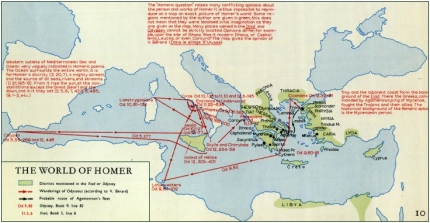
Odysseus's Travels
The departure.

Odysseus's Travels.

Lotus Eaters

The Cyclops

Aeolus The Wind King

Laestrygones

Circe's Island

Land of the Dead

King Alcinious

The Final Battle


COMMENTS
10.Charybdis / Scylla. whirlpool or 6 head moster. 11.Thrinakia. Odysseus and men stay on island overnight. If the cattle is touched there will be consequences. Men eat cattle and zeus destroys their ship killing all men just leaving Odysseus. Study with Quizlet and memorize flashcards containing terms like 1.Troy, 2.Cicones, 3.Lotus Eaters and ...
This is a timeline of Odysseus' Journey From Ithaca to the Trojan War Then Back Home by: Emilia Irovic There was a call to war of the Achaeans (Greeks) against the people of Troy. This war, the Trojan War, started because Paris, the Trojan prince, abducted (or eloped with) Helen, the wife of Menelaus. Menelaus convinced his brother, Agamemnon, the king of Mycenae, to lead an expedition to find ...
Odysseus Journey Map. The Greeks celebrate their victory over Troy at the beginning of the Odyssey, forgetting that it was not their own strength that won the city, but rather the will of the gods. In light of this neglect to give credit where it is due, Athena and Poseidon become very angry. They begged Zeus to make the Greeks suffer, and he ...
The Odyssey, one of Homer's two great epics, narrates Odysseus' long, strange trip home after the Trojan war.During their ten-year journey, Odysseus and his men had to overcome divine and natural forces, from battering storms and winds to difficult encounters with the Cyclops Polyphemus, the cannibalistic Laestrygones, the ...
This map shows Odysseus' journey after he left Troy. While his encounters were fictional — there were no Lotus Eaters, Sirens, or Cyclopes in the ancient Mediterranean — his ports of call were real. As you can see from the names of the modern nations, the bards who sang of Odysseus sent him to very real places in the Greek world.
A map illustrating the journey home of the Achaean warrior-king Odysseus after the Trojan war.His travel from Troy to Ithaca (and his wife Penelope) took innumerable twists and turns and lasted ten years. Ever since Homer's Odyssey was written about 600 BCE (and undoubtedly long before that), people have been trying to plot the hero's trek on the Mediterranean map.
Timeline. Map. After the Trojan war, Odysseus and his men set sail from Troy. They plunder the Cicones but are routed by reinforcements. On the island of the lotus eaters, some men eat the food of the enchanting inhabitants and loose all hope of home. On the Island of the Cyclops, Odysseus's curiosity causes him trouble: he and twelve others ...
Adventures and trials to overcome. Circe offering the cup to Odysseus- John William Waterhouse. Ulysses goes through the greatest trials, in which he will lose his men. In these two years, he has his quarrel with the Cicones, the Lotus eaters, the Cyclops, he goes to the island of Aeolus, he meets Circe, they escape from the Sirens and go to ...
The travels of Odysseus have inspired writers for more than 2,000 years. The Roman poet Virgil wrote The Aeneid in the late 1st century BCE. The Aeneid is the story of Aeneas, as The Odyssey is the story of Odysseus. Both books tell the legend of the Trojan Horse, and both the Trojan Prince Aeneas and the Greek King Odysseus have adventures
In summary the events described in Homer's Odyssey refer chronologically to the years immediately following the conquering of the city of Troy by the Achaeans (Greeks), around the end of the 13th and the beginning of the 12th century BC. At that time sailing could only make use of the classic stern wind, since the so-called 'Latin sail ...
The Odyssey Odysseus--soldier, sailor, trickster, and everyman--is one of the most recognizable characters in world literature. His arduous, ten-year journey home after the Trojan War, the subject of Homer's Odyssey, is the most accessible tale to survive from ancient Greece, and its impact is still felt today across many different cultures.
Ismaros. After leaving Troy, Odysseus traveled to the city of the Cicones, Ismaros, to search for food and water. Also, to have some adventures, of course! Thankfully, Ismaros is quite often included in Greece tours, following the assumption that this is precisely where Ismaros was located. However, assumption is the keyword here.
The travels of Odysseus have inspired writers for more than 2,000 years. The Roman poet Virgil wrote The Aeneid in the late 1st century B.C.E. The Aeneid is the story of Aeneas, as The Odyssey is the story of Odysseus. Both books tell the legend of the Trojan Horse, and both the Trojan Prince Aeneas and the Greek King Odysseus have adventures ...
A long time ago, in the land of Greece, there lived a man named Odysseus. When the Trojan War broke out, Odysseus left his home in Ithaca to go fight in Troy. His journey back from the war took a little bit longer than expected, more or less 10 years longer than expected. The following timeline will chronicle Odysseus's journey from the time he left Ithaca, to when he was first shown in Homer ...
The Odyssey, one of Homer's two great epics, narrates Odysseus' long, strange trip home after the Trojan war.During their ten-year journey, Odysseus and his men had to overcome divine and natural forces, from battering storms and winds to difficult encounters with the Cyclops Polyphemus, the cannibalistic Laestrygones, ...
Expert Answers. Odysseus visits a great many places -- most of them not by choice, after he leaves Troy. We first encounter Odysseus on the island of Ogygia, which belongs to the nymph Calypso. He ...
After the end of the Trojan war, Odysseus, like everyone else, began his long journey home, to the island of Ithaca. And yet, everyone managed to return to their loved ones except Odysseus who wandered for ten whole years through seas and countries far away from home, enduring many hardships until finally reaching Ithaca.
In Greek mythology, Odysseus is the great-grandson of Hermes, one of the twelve Olympian Gods. He is the son of Laertes, the king of Ithaca, and Anticlea and the husband of Penelope and father of a child named Telemachus. Known for his leadership skills, wit, and intelligence, Odysseus is most famous for his ten-year journey had after the ...
In Greek and Roman mythology, Odysseus (/ ə ˈ d ɪ s i ə s / ə-DISS-ee-əs; Greek: Ὀδυσσεύς, Ὀδυσεύς, translit. Odysseús, Odyseús, IPA: [o.dy(s).sěu̯s]), also known by the Latin variant Ulysses (/ juː ˈ l ɪ s iː z / yoo-LISS-eez, UK also / ˈ juː l ɪ s iː z / YOO-liss-eez; Latin: Ulysses, Ulixes), is a legendary Greek king of Ithaca and the hero of Homer's epic ...
Throughout his travels, Odysseus encounters many obstacles and dangers, including the wrath of the sea god Poseidon, who seeks revenge for the blinding of his son Polyphemus by Odysseus. Many of the dangers that Odysseus encountered on his journey home, can also be found in the Percy Jackson books. One of the key themes of the Odyssey is the ...
Odysseus was a legendary hero in Greek mythology, king of the island of Ithaca and the main protagonist of Homer's epic, the "Odyssey." The son of Laertes and Anticlea, Odysseus was well known among the Greeks as a most eloquent speaker, an ingenious and cunning trickster. One of the suitors of Helen, Odysseus was obliged to join the Trojan expedition - something he didn't want to ...
We can be relatively sure that Homer's audience of sea-faring traders would have done a similar exercise, trying to match Odysseus' travels with their own experiences in the Mediterranean. Read books 8-13 carefully, and gather as much empircal data as you can. Try to produce your own rough map of Odysseus' journey.
Odysseus did his best to defeat the Trojans, but couldn't because of Poseidon. So with some skillful thinking Odysseus came up with a plan to defeat the Trojans. Jun 28, 1901. Cicones After an already long journey, Odysseus and his men landed on the island of the people called Cicones. The weary travelers docked their ship in a bay and scouts ...